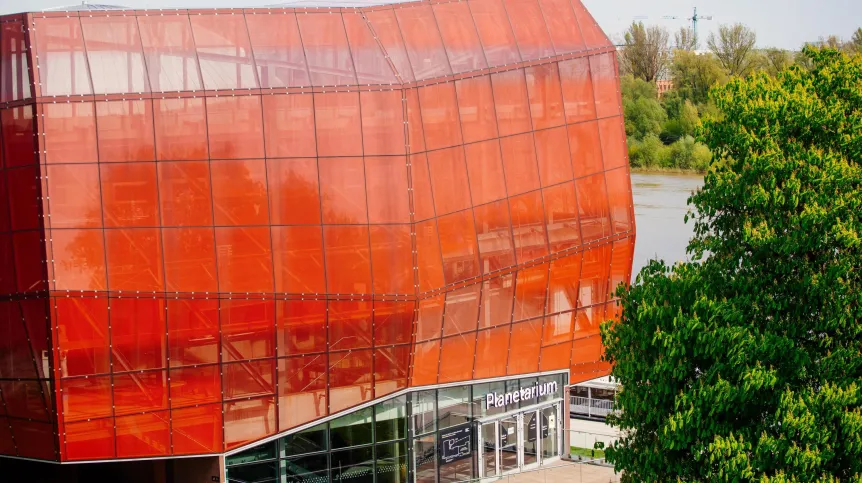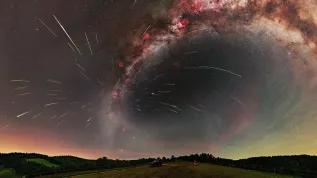
The first images from the Vera Rubin Observatory in Chile were presented last week during a global premiere event held simultaneously in over 300 institutions worldwide, including the Copernicus Science Centre Planetarium in Warsaw. The unveiling, part of the international “Rubin First Look,” marked what researchers are calling the beginning of a new era in astronomy.
The official broadcast, streamed live from the U.S. National Science Foundation (NSF) headquarters in Washington, D.C., took place on Monday at 11:00 a.m. EDT (5:00 p.m. CET). The event showcased the inaugural observations captured by the Simonyi Survey Telescope, a state-of-the-art 8.4-meter telescope located on Cerro Pachón in Chile’s Atacama Desert. The observatory is equipped with the largest digital camera ever built, with a resolution of 3,200 megapixels.
Among the first images shown to the public were striking, high-resolution views of the Trifid and Lagoon nebulae—colorful stellar nurseries located thousands of light-years from Earth—and the spiral galaxy Messier 49, located in the Virgo constellation.
Describing the impact of the observatory’s capabilities, Professor Paweł Pietrukowicz of the Astronomical Observatory at the University of Warsaw said: “It is a very large telescope, the likes of which have not been seen before in continuous observations of the sky, and there is always something going on in the sky. There are many phenomena that we will be able to explain only if we can observe them and analyse data on a mass scale. Among the millions of new phenomena in the sky that the Vera Rubin Observatory will record every night, there must be phenomena and objects that we now have no idea about.”
The observatory’s flagship mission, the Legacy Survey of Space and Time (LSST), is scheduled to begin later this year following final calibration. Over the course of ten years, the observatory will systematically scan the entire visible southern sky approximately 800 times. The data collected is expected to include more than 40 billion celestial objects—ranging from stars in the Milky Way to distant galaxies and solar system bodies such as asteroids.
Polish scientists are part of the international team of around 2,000 researchers from 27 countries. Several dozen astronomers and analysts from Poland are involved through institutions including the National Centre for Nuclear Research (NCBJ), the Centre for Theoretical Physics of the Polish Academy of Sciences, the Nicolaus Copernicus Astronomical Center, the University of Warsaw, the Jagiellonian University, the Nicolaus Copernicus University in Toruń, the Adam Mickiewicz University in Poznań, and the University of Wrocław.
“As part of the Polish contribution to this project, we are building, among other things, a data analysis centre,” said Professor Agnieszka Pollo, acting director of the NCBJ and head of the Polish Rubin consortium. “We hope that thanks to this, not only our astronomers, but also computer scientists and programmers will play a significant role in the project and the development of new data analysis methods.”
Professor Pollo emphasised the unique technological power of the observatory, saying: “As a result, after 10 years we will obtain an unprecedentedly accurate, colour film showing the variability and movements of various astronomical sources in the entire southern sky. The project will provide huge amounts of astronomical data—data that cannot be analysed without the help of machine learning and artificial intelligence. It will also be an excellent field for developing new automatic methods that can then be used in other fields.”
One of the major scientific goals of the observatory is to study the effects of dark matter and dark energy on the structure of the Universe, as well as to detect dynamic events such as stellar explosions or galactic flares.
Pollo noted that the Vera Rubin Observatory may help solve long-standing cosmic mysteries. “We have been discovering galaxies of this type [with low surface brightness] in greater numbers only recently, but we already know that they may constitute as much as half of all known galaxies. Understanding why they exist in the Universe may be the key to explaining the nature of dark matter,” she said.
The Vera Rubin Observatory is named after the late American astronomer Vera Cooper Rubin, whose pioneering work provided the first compelling evidence for the existence of dark matter. The project is managed jointly by the U.S. National Science Foundation and the U.S. Department of Energy, in collaboration with global scientific institutions. It has also received financial support from private donors, including Charles Simonyi—known as the "father of Excel"—and Microsoft co-founder Bill Gates.
Final preparations for the observatory’s full operation are currently underway. Researchers anticipate that the LSST will officially begin before the end of the year, setting in motion what many scientists believe will be a decade of unprecedented astronomical discovery. (PAP)
abu/ bar/













